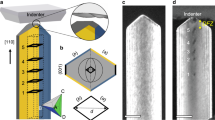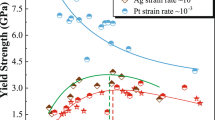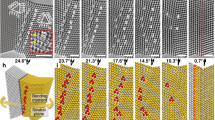Abstract
The increase in semiconductor conductivity that occurs when a hard indenter is pressed into its surface has been recognized for years1,2,3,4,5, and nanoindentation experiments have provided numerous insights into the mechanical properties of materials. In particular, such experiments have revealed so called pop-in events, where the indenter suddenly enters deeper into the material without any additional force being applied; these mark the onset of the elastic–plastic transition6,7,8,9,10,11. Here, we report the observation of a current spike—a sharp increase in electrical current followed by immediate decay to zero at the end of the elastic deformation—during the nanoscale deformation of gallium arsenide. Such a spike has not been seen in previous nanoindentation experiments on semiconductors1,2,3,4,5, and our results, supported by ab initio calculations, suggest a common origin for the electrical and mechanical responses of nanodeformed gallium arsenide. This leads us to the conclusion that a phase transition is the fundamental cause of nanoscale plasticity in gallium arsenide12, and the discovery calls for a revision of the current dislocation-based understanding of nanoscale plasticity6,7,8,9,10,11.
This is a preview of subscription content, access via your institution
Access options
Subscribe to this journal
Receive 12 print issues and online access
$259.00 per year
only $21.58 per issue
Buy this article
- Purchase on Springer Link
- Instant access to full article PDF
Prices may be subject to local taxes which are calculated during checkout





Similar content being viewed by others
References
Gerk, A. P. & Tabor, D. Indentation hardness and semiconductor–metal transition of germanium and silicon. Nature 271, 732–733 (1978).
Clarke, D. R., Kroll, M. C., Kirchner, P. D., Cook, R. F. & Hockey, B. J. Amorphization and conductivity of silicon and germanium induced by indentation. Phys. Rev. Lett. 60, 2156–2159 (1988).
Gilman, J. J. Insulator–metal transitions at microindentations. J. Mater. Res. 7, 535–538 (1992).
Bradby, J. E., Williams, J. S. & Swain, M. V. In situ electrical characterization of phase transformations in Si during indentation. Phys. Rev. B 67, 085205 (2003).
Ruffell, S., Bradby, J. E., Fujisawa, N. & Williams, J. S. Identification of nanoindentation-induced phase changes in silicon by in situ electrical characterization. J. Appl. Phys. 101, 083531 (2007).
Corcoran, S. G., Colton, R. J., Lilleodden, E. T. & Gerberich, W. W. Anomalous plastic deformation at surfaces: Nanoindentation of gold single crystals. Phys. Rev. B 55, R16057–R16060 (1997).
Li, J., Van Vliet, K. J., Zhu, T., Yip, S. & Suresh, S. Atomistic mechanisms governing elastic limit and incipient plasticity in crystals. Nature 418, 307–310 (2002).
Schuh, C. A., Mason, J. K. & Lund, A. C. Quantitative insight into dislocation nucleation from high-temperature nanoindentation experiments. Nature Mater. 4, 617–621 (2005).
Szlufarska, I., Nakano, A. & Vashista, P. A. Crossover in the mechanical response of nano-crystalline ceramics. Science 309, 911–914 (2005).
Gerberich, W. & Mook, W. A new picture of plasticity. Nature Mater. 4, 577–578 (2005).
Minor, A. M. et al. A new view of the onset of plasticity during the nanoindentation of aluminium. Nature Mater. 5, 697–702 (2006).
Chrobak, D., Nordlund, K. & Nowak, R. Nondislocation origin of GaAs nanoindentation pop-in event. Phys. Rev. Lett. 98, 045502 (2007).
Giannakopoulos, A. E. & Suresh, S. Theory of indentation of piezoelectric materials. Acta Mater. 47, 2153–2164 (1999).
Sridhar, S., Giannakopoulos, A. E., Suresh, S. & Ramamurty, U. Electrical response during indentation of piezoelectric materials: A new method for material characterization. J. Appl. Phys. 85, 380–388 (1999).
Le Bourhis, E. & Patriarche, E. TEM-nanoindentation studies of semiconducting structures. Micron 38, 377–389 (2007).
Leipner, H. S., Lorentz, D., Zecker, A., Lei, H. & Grau, P. Nanoindentation pop-in effect in semiconductors. Physica B 308–310, 446–449 (2001).
Bradby, J. E., Williams, J. S., Wong-Leung, J., Swain, M. V. & Munroe, P. Mechanical deformation of InP and GaAs by spherical indentation. Appl. Phys. Lett. 78, 3235–3237 (2001).
Mujica, A., Rubio, A., Munoz, A. & Needs, R. J. High-pressure phases of group-IV, III–V, and II–VI compounds. Rev. Mod. Phys. 75, 863–912 (2003).
Bourret, E. D. et al. Silicon and indium doping of GaAs: Measurements of the effect of doping on mechanical behavior and relation with dislocation formation. J. Cryst. Growth 85, 275–281 (1987).
Williams, J. S., Chen, Y., Wong-Leung, J., Kerr, A. & Swain, M. V. Ultra-micro-indentation of silicon and compound semiconductors with spherical indenters. J. Mater. Res. 14, 2338–2343 (1999).
Leipner, H. S., Lorentz, D., Zeckzer, A. & Grau, P. Dislocation-related pop-in in gallium arsenide. Phys. Stat. Sol. 183, R4–R6 (2001).
Lorentz, D. et al. Pop-in effect as homogeneous nucleation of dislocations during nanoindentation. Phys. Rev. B 67, 172101 (2003).
Woodall, J. M. et al. Fermi-level pinning by misfit dislocations at GaAs interfaces. Phys. Rev. Lett. 51, 1783–1786 (1983).
Ovsyannikov, S. V. & Shchennikov, V. V. Observation of a new high-pressure semimetal phase of GaAs from pressure dependence of thermopower. J. Phys. Condens. Matter 18, L551–L557 (2006).
Nowak, R., Sekino, T., Maruno, S. & Niihara, K. The deformation of sapphire induced by a spherical indentation on the (1010) plane. Appl. Phys. Lett. 68, 1063–1065 (1996).
Nowak, R. et al. Peculiar surface deformation of sapphire: Numerical simulation of nanoindentation. Appl. Phys. Lett. 83, 5214–5216 (2003).
Valentini, P., Gerberich, W. W. & Dumitrica, T. Phase-transformation plasticity response in uniaxially compressed silicon nanospheres. Phys. Rev. Lett. 99, 175701 (2007).
Baroni, S., de Gironcoli, S., Corso, A. D. & Giannozzi, P. Phonons and related crystal properties from density-functional perturbation theory. Rev. Mod. Phys. 73, 515–562 (2001).
Perdew, J. P. & Zunger, A. Self-interaction correction to density-functional approximations for many-electron systems. Phys. Rev. B 23, 5048–5079 (1981).
Monkhorst, H. J. & Pack, J. D. Special points for Brillouin-zone integrations. Phys. Rev. B 13, 5188–5192 (1976).
Acknowledgements
This research was supported by the Academy of Finland under FINNANO research project NANOTOMO and NAKAMA-EXT., Research Foundation of Helsinki University of Technology, while the nanoECR measurements were carried out courtesy of Hysitron, Inc. at their laboratories. R.N. acknowledges W.W. Gerberich, I. Szlufarska and C.A. Schuh for their careful reading of the initial version of the manuscript and for providing stimulating comments, as well as special thanks to F. Yoshida and R. Tenne for invaluable discussions.
Author information
Authors and Affiliations
Contributions
R.N. conceived the concepts and designed the research project. D.C. and S.N. carried out the calculations and analysed the compatibility of theoretical and experimental data. D.V. and M.B. carried out the experiments and analysed the output. A.T. and M.P. designed and fabricated GaAs specimens. R.N., M.B. and D.C. wrote the paper. All authors discussed the results.
Corresponding author
Supplementary information
Supplementary Information
Supplementary Information (PDF 1086 kb)
Rights and permissions
About this article
Cite this article
Nowak, R., Chrobak, D., Nagao, S. et al. An electric current spike linked to nanoscale plasticity. Nature Nanotech 4, 287–291 (2009). https://doi.org/10.1038/nnano.2009.49
Received:
Accepted:
Published:
Issue Date:
DOI: https://doi.org/10.1038/nnano.2009.49
This article is cited by
-
Investigations of Phase Transformation in Monocrystalline Silicon at Low Temperatures via Nanoindentation
Scientific Reports (2017)
-
Magnetic Field Tunable Small-scale Mechanical Properties of Nickel Single Crystals Measured by Nanoindentation Technique
Scientific Reports (2014)
-
Deformation and fracture of a mudflat-cracked laser-fabricated oxide on Ti
Journal of Materials Science (2013)
-
Deconfinement leads to changes in the nanoscale plasticity of silicon
Nature Nanotechnology (2011)



